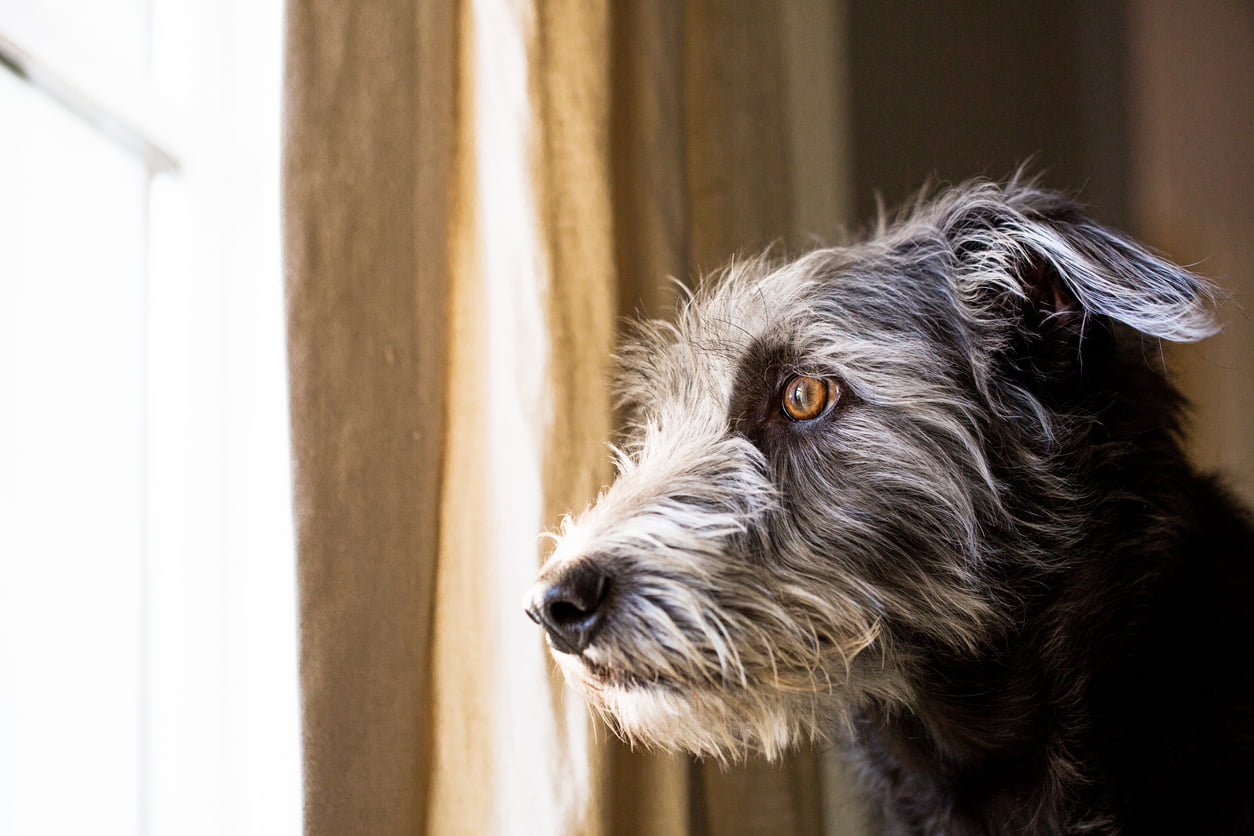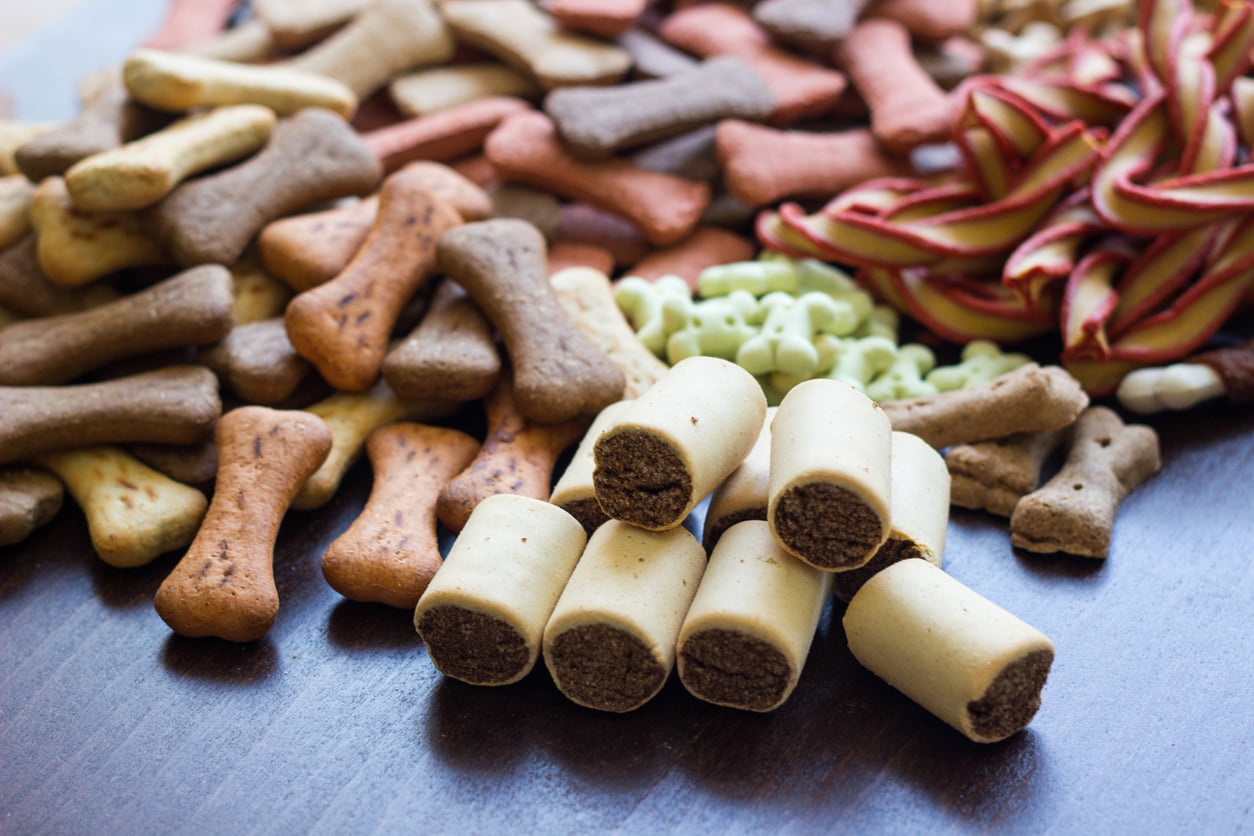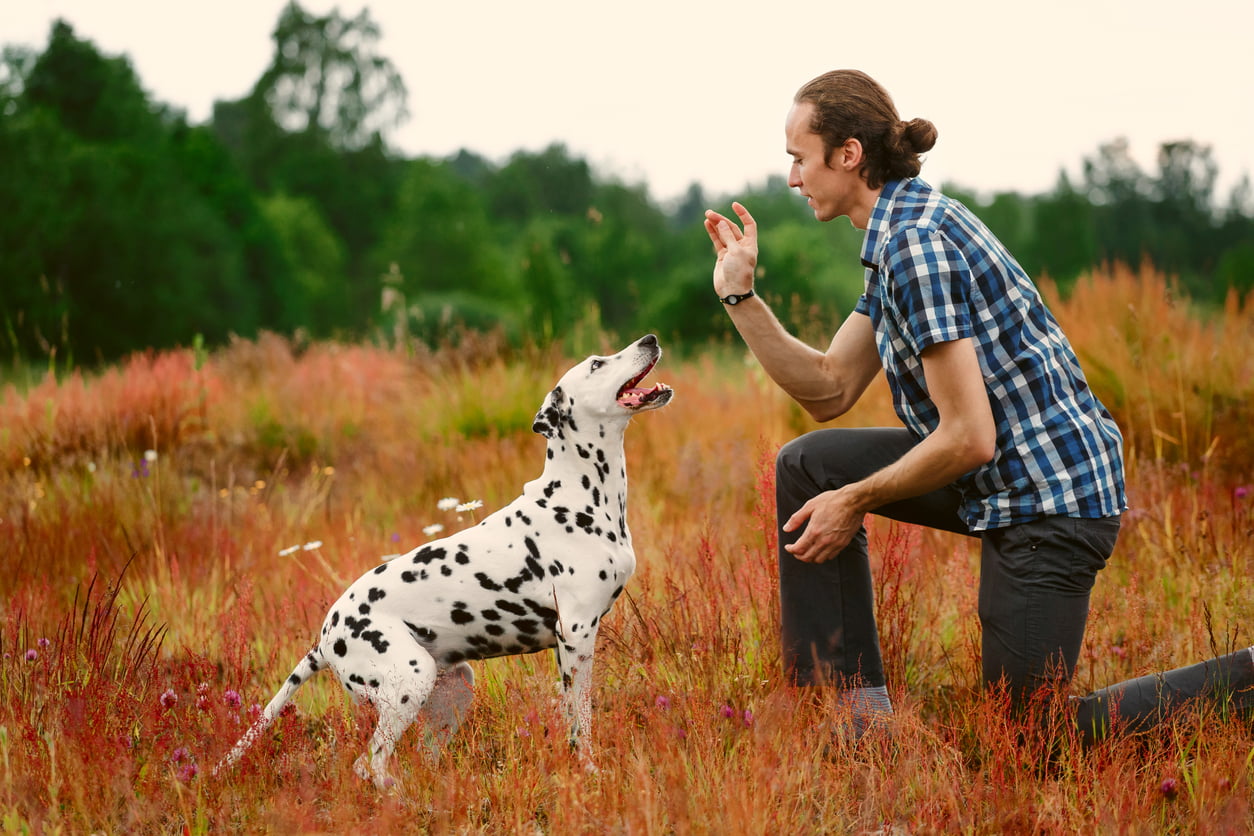Struggling with your furry friend’s anxiety? In this article, we’ll show you how to calm an anxious dog with straightforward and effective techniques. From recognizing the signs of distress to providing comfort and stability, you’ll learn how to ease their anxiety and restore calmness naturally. Clear guidance on immediate and long-term solutions is coming your way.
Key Takeaways
- Spot and address anxiety symptoms in dogs quickly to prevent escalation.
- Use affection, exercise, mental games, and safe spaces to reduce stress.
- Consult experts for persistent or severe anxiety cases.
Understanding Your Dog’s Anxiety

Anxiety in dogs, much like in humans, is essentially a state of worry about things that may or may not happen. Over 70% of dogs will experience some form of anxiety at some point in their lives, making it a commonplace yet concerning issue. It’s not just about the occasional nervous whine or the tail tucked between the legs. Unaddressed anxiety can lead to:
- a shorter lifespan
- health complications
- destructive behavior
- aggression
- other behavioral problems
Hence, comprehending your dog’s anxiety paves the way to help them alleviate this distressing condition. Just as you would extend your support to a worried friend, your anxious dog needs your patience, understanding, and care. But how do you recognize anxiety in your canine companion?
Identifying Anxiety Symptoms
An anxious dog might not just ‘tell’ you about their worries, but their behavior can give you some clear hints. Signs of anxiety in dogs include:
- Whining
- Barking
- Shivering
- Whimpering
- Destructive behavior
- Hostility
- Withdrawal
Changes in appetite, often characterized by a loss of appetite, can also be a symptom of your dog’s distress.
Aggression, in particular, can be a distinct sign of anxiety. Anxious dogs might exhibit aggressive behaviors that differ from other forms of aggression in dogs. Calming techniques such as playing classical music, which dogs prefer, can be used to treat this behavior effectively.
Common Causes of Anxiety in Dogs
Effectively managing anxiety requires pinpointing its root causes. Dogs can become anxious due to numerous factors, including:
- traumatic experiences
- changes in routine or environment
- fear
- separation from their owner
- age-related cognitive dysfunction
These triggers can lead to a dog anxious and exhibiting various anxious behaviors, often seen in the dog’s reaction to trigger anxiety.
Age-related anxiety in dogs usually originates from cognitive dysfunction syndrome (CDS), a condition similar to the early stages of Alzheimer’s in humans. It leads to a decline in memory, learning, perception, and awareness, which can make senior dogs feel confused and anxious. Recognizing and understanding these triggers can help us support our canine friends effectively.
Calming Techniques for Anxious Dogs

After recognizing your dog’s anxiety causes and symptoms, consider exploring diverse calming techniques to ease their stress and foster relaxation. These strategies range from providing physical contact and affection, maintaining a regular exercise routine, to creating a safe and comfortable environment.
Let’s delve deeper into these techniques.
Physical Contact and Affection
Stroking or snuggling with a dog can diminish their cortisol levels and trigger the release of oxytocin, a hormone associated with positive feelings, thus reducing their stress. This can help decrease separation-related anxiety, fear, and overall anxiety in dogs. Gentle petting or cuddling can work wonders when it comes to comforting an anxious dog. However, approach them calmly, avoid leaning over, and steer clear of head-on approaches, as these might increase their anxiety.
The best way to help an anxious dog is to let them take the lead in seeking play and affection. When they take the initiative, give them ample physical contact and communication. This approach helps them feel safe and in control of the social interaction.
Exercise and Mental Stimulation

Physical activity can exhaust an anxious dog, triggering endorphin release to instill calmness. In addition, providing mental stimulation through interactive toys, puzzles, and games can engage their mind and reduce anxiety. Regular exercise and stimulation are vital for a dog’s overall development and well-being. A well-stimulated dog is less likely to develop destructive behaviors, which in turn helps reduce the chances of anxiety.
Some great mental stimulation games to reduce a dog’s anxiety are:
- Hide and Seek
- Teaching Dog Tricks
- Scatter Feeding
- Using Food Puzzles
- Providing Interactive Dog Toys
- Playing games like Put
Mental stimulation helps dogs burn off extra energy and feel more relaxed. It also helps prevent stress, depression, and age-related mental decline, which can all lead to a decrease in anxiety.
Creating a Safe and Comfortable Environment
Establishing a secure and comfortable haven for your dog can significantly contribute to anxiety reduction. Anxious dogs can find comfort and security in cozy canvas crates, quiet corners, or spare bedrooms. These spaces provide a sense of safety for them to relax and unwind. Adding your dog’s favorite toys, blankets, or beds in their safe space can help them feel more comfortable and relaxed, which can significantly help to reduce their anxiety.
There are also innovative products like the ZenCrate, a unique crate for dogs that has:
- Vibration isolation
- Noise cancellation
- Reduced light
- Comfort features
- Motion-activated sensor for a gentle fan
- Pre-programmed calming music to soothe the dog
The ZenCrate can help dogs feel less anxious, especially those with separation anxiety, fear of loud noises, or storm phobia.
Natural Remedies for Dog Anxiety
Natural remedies offer a gentle yet effective way to manage your dog’s anxiety without the use of medication. From calming supplements and treats to music therapy and aromatherapy, these remedies can help your dog navigate their world with greater calm and confidence.
Calming Supplements and Treats

Natural ingredients in calming supplements and treats can aid in alleviating your dog’s anxiety. Ingredients such as hemp, chamomile, turkey, casein, tryptophan, melatonin, and L-theanine can help calm dogs down, make them relax, and reduce their anxiety. Brands such as Zesty Paws, PetHonesty, Open Farm, Lord Jameson, VetriScience, NaturVet, Thundershirt, Green Coast Pet, Pupper, Penguin CBD, and Elm & Rye offer reputable calming supplements and treats for dogs.
Probiotic supplements also play a significant role in maintaining a healthy balance of good bacteria in the stomach, promoting a sense of calm and overall well-being for the dog, ultimately helping to relieve anxiety. However, it’s always a good idea to consult a veterinarian before introducing any new supplements or treats to your dog’s diet.
Music Therapy for Dogs
The practice of music therapy uses certain music genres to soothe and relax dogs. When dogs listen to music, especially classical music, it has a calming and soothing effect on them, which can positively change their mood and behavior. In fact, dogs prefer classical music, along with soft rock and reggae, as these genres are the most effective for calming dogs and reducing their anxiety.
You can help calm anxious dogs by playing classical, soft rock, or reggae music in a comfortable setting, with very quiet music playing. These genres have been shown to be particularly effective in soothing an anxious canine. You can find curated playlists for this on platforms like DogTV, Spotify, and Relax My Dog.
Aromatherapy and Essential Oils
Aromatherapy and essential oils can effectively relax and soothe anxious dogs as well. Pheromone products, such as the Adaptil Home Diffuser, release soothing scents that imitate calming signals from mother dogs, which can help ease anxiety in dogs. Essential oils such as:
- Lavender
- Chamomile
- Myrrh
- Ginger
- Rosemary
- Bergamot
- Frankincense
- Cornmint
- Turmeric
- Cedarwood
- Copaiba
- Arborvitae
- Petitgrain
can be used for dog aromatherapy without any safety concerns.
Aromatherapy can help anxious dogs relax and feel calm. It can address issues like:
- separation anxiety
- fear
- insomnia
- hyperactivity
- digestive problems
- itchiness
However, before using any essential oils, make sure to mix them with a neutral carrier for safe use on dogs.
Training and Behavior Modification

Behavioral training and modification prove to be potent strategies in managing and mitigating your dog’s anxiety. Techniques such as:
- Desensitization
- Counterconditioning
- Obedience training
- Socialization
Our canine and feline friends can experience anxiety just like humans, sometimes even due to interactions with other dogs. This product can help dog owners overcome anxiety triggers in their pets and promote calm behavior.
Desensitization and Counterconditioning
The methods of desensitization and counterconditioning assist your dog in conquering anxiety triggers. Desensitization involves gradually getting your dog used to what makes them anxious, in small steps and with rewards for good behavior. Counterconditioning, on the other hand, is about turning a scary thing into something positive for the dog.
Desensitizing a dog to their anxiety triggers should be done gradually, ensuring not to rush the process as it can set back the training. High-value treats, like chicken or cheese, should be offered to the dog during desensitization training sessions to encourage positive behavior.
Obedience Training and Socialization
Imparting obedience training and promoting socialization are crucial in preventing and managing dogs’ anxiety. Obedience training sets the stage for a strong relationship and builds trust. The best obedience training techniques for dogs with anxiety involve using positive training methods, ignoring and redirecting unwanted behavior, and using rewards to encourage the dog.
Socialization helps dogs in the following ways:
- Avoid getting anxious and developing behaviors like aggression and separation anxiety
- Learn how to be social and explore their surroundings
- Lower their anxiety and the chances of having behavior problems
Professional Help and Alternative Therapies
Despite our utmost efforts, our dogs might still grapple with anxiety. In such instances, seeking professional guidance becomes imperative. Veterinarians and behaviorists can provide expert guidance and suggest alternative therapies that may provide relief.
When to Consult a Veterinarian or Behaviorist
If your dog starts exhibiting any of the following behaviors, it might be time to seek professional help:
- Being destructive
- Being aggressive
- Barking or whining a lot
- Trembling
- Becoming overly dependent on human family members
Behaviorists can be especially helpful for more complex behavioral issues that go beyond basic obedience training.
Seeking professional help can offer numerous benefits. Professionals can help with:
- Addressing behaviors caused by fear, anxiety, and aggression
- Teaching obedience training
- Providing advice that can help you bond with your dog and meet their specific needs.
Acupuncture, Massage, and Other Therapies
Anxious dogs may find relief through unconventional therapies like acupuncture, massages, and light therapy. Acupuncture focuses on certain pressure points to bring back balance and encourage relaxation. It’s a painless process where tiny needles are inserted into certain pressure points on the dog’s body, and the dog gets to relax on a comfy mat during the process.
Massage therapy, too, can help relax an anxious dog by releasing tension from their muscles and inducing a state of relaxation. But before trying these less conventional options, consult a professional to ensure they’re safe and effective.
Preventing Anxiety in Dogs
Prevention outweighs cure. Keeping routines consistent, promoting adequate socialization, and early exposure to diverse stimuli can aid in averting the onset of anxiety in dogs.
Consistent Routines and Schedules
Upholding regular routines and timetables can instill a sense of security and tranquility in your dog. A regular schedule makes them feel secure and ensures they know what to expect throughout the day, providing a sense of predictability and stability.
Consistent feeding schedules, in particular, can contribute to a dog’s overall sense of security. Feed your dog at specific times of the day, maintaining consistent serving sizes.
Proper Socialization and Exposure
Adequate socialization and exposure play a significant role in preventing dogs’ anxiety. Puppies can start socializing as early as 7 to 8 weeks of age. Socializing helps dogs avoid anxiety and developing behaviors like aggression and separation anxiety.
It also teaches puppies how to be social and explore their surroundings, which can lower their anxiety and the chances of having behavior problems.
Summary
We’ve journeyed through the world of an anxious dog, understanding their fears, identifying their symptoms, and exploring various techniques, natural remedies, and therapies that can help manage and reduce their anxiety. Remember, patience, understanding, consistent routines, and a safe environment can go a long way in easing your dog’s worries. Let’s aim to create a world where every tail wag is a sign of happiness, not stress!
Frequently Asked Questions
How do I stop my dog from being anxious?
You can calm an anxious dog by providing regular exercise, physical contact, massage, and using calming coats or shirts, along with alternative therapies if necessary. Consider trying these methods to see what works best for your furry friend!
Can dogs overcome anxiety?
Yes, dogs can overcome anxiety through training techniques like desensitization and counterconditioning, which involve controlled exposure to the fear and anxiety stimulus. This can help them manage and reduce their anxiety.
What are the signs of anxiety in dogs?
If your dog is showing signs like whining, barking, destructive behavior, or withdrawal, they might be experiencing anxiety. It’s important to consult with a veterinarian for proper guidance and support.
How does physical contact and affection help an anxious dog?
Physical contact and affection can lower a dog’s stress levels by reducing cortisol and releasing oxytocin, a hormone linked to positive emotions, which helps an anxious dog feel more secure and calm.
When should I consult a veterinarian or behaviorist for my dog’s anxiety?
It’s important to consult a veterinarian or behaviorist if your dog shows signs of destructiveness, aggression, excessive barking, trembling, or over-dependence on humans. Seeking professional help is crucial in these situations.
